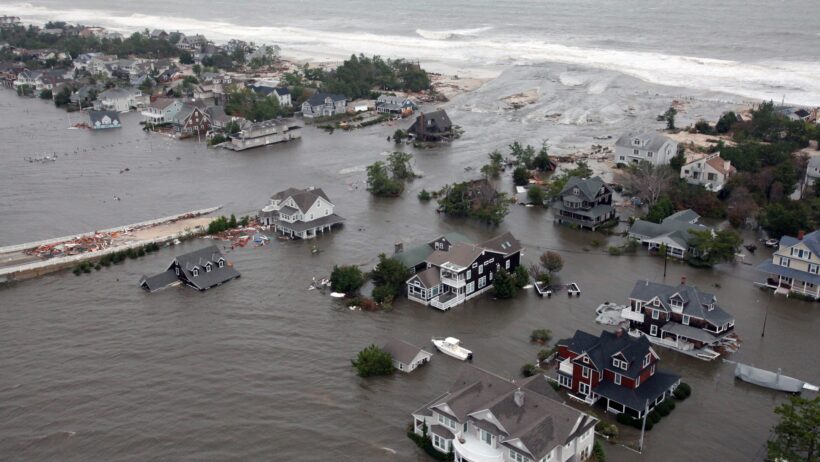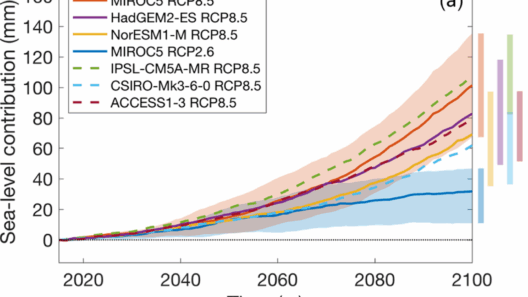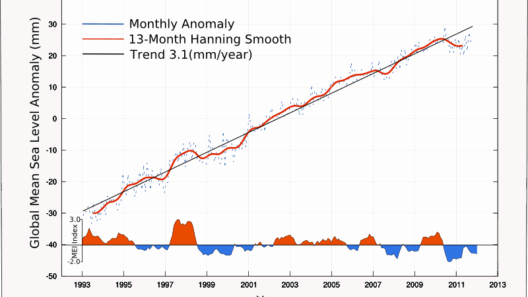As the planet warms, a pressing question emerges: Are sea levels rising due to climate change? The answer is not just an academic concern; it poses a significant threat to human civilization and our entire ecosystem. This article endeavors to unravel the complex mechanisms by which global warming drives the inexorable rise of our oceans, prompting a collective reevaluation of our role in this unfolding crisis.
Understanding the science of sea level rise is paramount. It is crucial to grasp the dual factors contributing to this phenomenon: thermal expansion of seawater and the melting of land-based ice. Both components are intimately linked to rising global temperatures, and together they form a powerful catalyst for rising sea levels.
Comprehending the thermal expansion of seawater requires an appreciation of basic physics: as water heats, it expands. In the last century, the average global temperature has surged, creating conditions for our oceans to absorb heat and swell in volume. Data from climate models indicate that for every one degree Celsius increase in temperature, sea levels could rise by approximately 0.4 meters. This seemingly small shift in temperature results in significant water displacement, leading to flooding in coastal zones and ecosystems of immense biodiversity.
Melting ice sheets and glaciers constitute the second and arguably more alarming contributor to rising sea levels. Greenland and Antarctica are losing ice at an alarming rate, discharging freshwater into oceans. The Greenland ice sheet’s melting has accelerated markedly over the past few decades; in fact, it is estimated to be losing nearly 250 billion tons of ice annually. This catastrophic loss not only contributes to rising sea levels but also disrupts oceanic currents, further exacerbating climate variability.
EXPLORE THE IMPACTS ON COASTAL COMMUNITIES
The consequences of rising sea levels penetrate deep into the fabric of coastal communities. Millions of individuals inhabit low-lying areas across the globe, where homes and livelihoods are now at stake. From Miami’s vibrant neighborhoods to Jakarta’s bustling streets, communities face increasingly routine flooding. The nexus of climate-induced displacement is now a pressing humanitarian issue. As regions become uninhabitable, societal tensions are anticipated to escalate, particularly pertaining to resource allocation and governance.
Moreover, the ecological ramifications of rising sea levels are profound. Coastal wetlands, which serve as critical buffers against storm surges and act as nurseries for marine life, are progressively inundated. Saltwater intrusion into freshwater systems jeopardizes drinking water supplies, leading to an alarming decline in agricultural productivity. The sanctity of biodiversity in these environments hangs in a precarious balance; the loss of habitat extirpates species, disrupting entire food webs.
THE ECONOMIC TOLL ON INFRASTRUCTURE
As sea levels rise, the economic toll becomes acutely evident. Infrastructure that once thrived in coastal areas is increasingly under threat. The financial repercussions manifest in various ways: property values plummet in vulnerable zones, and flood insurance premiums skyrocket. Cities sprawled along coastlines face mounting costs for adaptive measures, such as building sea walls and enhancing drainage systems to combat the impending inundation.
Furthermore, the long-term sustainability of industries reliant on stable coastlines is now in jeopardy. The fishing industry, integral to communities and economies alike, faces upheaval as habitats shift and species migrate in response to changing oceanic conditions. Tourism also dwindles when pristine beaches become washed away, reducing the allure of coastal destinations that once drew millions.
AN URGENT CALL TO ACTION
In light of the catastrophic trajectory we face, a clarion call for action reverberates across the globe. Addressing the roots of climate change requires an unprecedented mobilization of collective will. Reduction of greenhouse gas emissions remains the paramount objective. Transitioning to renewable energy sources, such as solar, wind, and geothermal, can significantly cut emissions while simultaneously fostering economic innovation.
Moreover, fostering robust community-driven adaptation strategies is crucial. Coastal cities must invest in resilient infrastructure and develop comprehensive plans to safeguard vulnerable populations in the face of rising waters. International collaboration is essential; nations must unite in climate agreements that hold each other accountable for progress and innovation in mitigating this global crisis.
Inextricably woven into the fabric of our existence, the reality of rising sea levels serves as a grim benchmark of our planet’s health. An essential shift in perspective is warranted—one that recognizes the interdependence of humanity and nature. As the surges of the oceans loom ever closer, the time is now to confront our complicity and champion transformative changes to secure a sustainable future.
In conclusion, the question of whether sea levels are rising due to climate change leads to an inescapable conclusion: the phenomenon is irrefutably real, and its implications are vast and far-reaching. Only by embracing our shared responsibility can we hope to forge a path that honors both our planet and future generations.






